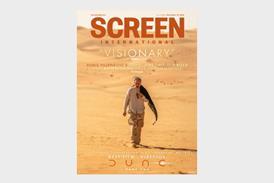Dir. Takeshi Kitano. Japan, 2003. 116 min.
A rousing, energetic take-off on a 19th century samurai tale which has become part of Japanese folklore, this black comedy, spurting fountains of digital blood and moving forward relentlessly at a fiery tempo, is a surprisingly entertaining departure for Takeshi Kitano from his dark combination of poetry and mayhem in modern yakuza dress. Though there is plenty of violence in his new film, it's impossible to take it seriously, so perfectly stylised and choreographed is each move. Kitano himself, playing the lead as usual, has never been more effective in his deadpan, underplayed acting, than he is here, as the blind masseur and master gambler wandering around the Japanese countryside and setting wrongs right with his mighty, invincible sword. With an explosive musical finale that drew enthusiastic applause at the Venice press screening, this is the kind of film that Kitano must have enjoyed doing immensely, and his fans will love watching again and again.
Zatoichi is a legendary figure which has been featured in no less than 26 Japanese movies, not to mention over 100 episodes made for television, all of them dedicated to this fictional hero who was always there to help the poor and the downtrodden against the miseries inflicted on them by the rich, the powerful and the crooked. Which is exactly what happens in this film, though Kitano makes sure his own picture is completely different from any of the many previous Zatoichi tales. Painting his hair blonde, using a red-blood cane sword and refusing to display any open feelings at any time, Kitano's Zatoichi isn't really anyone's friend, as he was traditionally conceived, he is first and foremost a superb slasher who with one swift move of his blade dispatches his enemies to their well-deserved death.
The schematic frame in which he moves is familiar enough from many Japanese historical epics, as well as from countless westerns and gangster movies. A village is persecuted by a band of criminals who eliminate the competition, demand protection, and massacre anyone who does not comply. They have hired a ruthless but penniless 'ronin' to terminate all their enemies, and might have the entire place under their thumb but for the unprepossessing blind man who just walks in, settles down in a widow's home, massages her back, visits the local gambling spot, displays some of his uncanny swordsmanship when he catches them cheating and starts a process which inevitably leads to the complete and merciless defeat of the villains. At which point, the entire village erupts in a raucous, frenetic tap dance celebration, a musical number that may be completely out of the historical context, but expresses better than anything else, the ecstatic relief of all inhabitants who are finally rid of their usurpers.
From the very first scene, when a gang of hoods approach the humbly dressed Zatoichi resting by the side of the road and learn at their lives' expense that they should not have messed with him, Kitano keeps the bloody confrontations going at top speed, the purpose of the few calm passages in-between being to provide some kind of continuity between one display of virtuosity and another. This refers not only to the swordplay, with which Kitano is familiar from his days on stage, but to the minute, clockwork direction of the actors, the choreography of the movements, the precision of the cutter, the seamless blend of sound effects and pumping rhythmical music, and of course the inventive staging of each scene.
Visual felicities may be less evident here than in his more artistically-inclined pictures, but it is still difficult to ignore some of his compositions, such patterns of straight lines with blotches of red blood between them, a combination of rain, sand and blood in a scene he refers to as 'a tribute to Kurosawa's Seven Samurai', or the orgy of colour and movement in the last scene. Kitano's dry humour is evident throughout, enforced by his minimal use of dialogue and extreme economy of movements, which only underlines the significance of each one of them. His preference for images rather than words to tell his story, which may take some getting used to, is often used telegraphically for short flashbacks. And if there are a few moments in the second hour, when it seems the film is out of breath, they don't last long before the action plunges on into the next swish-of-the-blade extravaganza.
Prod co: Bandai Visual, Tokyo FM, Dentsu, TV Asahi, Saito Entertainment, Office Kitano
Prods: Masayuki Mori, Tsunehisa Saito
Exec prod: Chieko Saito
Scr & ed: Takeshi Kitano, based on story by Kan Shimozawa
Cinematography: Katsumi Ianagijima
Co-ed: Yoshinori Ota
Prod des: Norihiro Isoda
Costumes: Kazuko Kurosawa
Music: Keichi Suzuki
Tap dance choreography: The Stripes
Sound: Senji Horiuchi
Main Cast: Beat Takeshi, Tadanobu Asano, Michiyo Ogusu, Yui Natsukawa, Gudalcanal Taka, Daigoro Tachibana, Yuko Daike,Ittoku Kishibe, Saburo Ishikura, Akira Emoto


















No comments yet